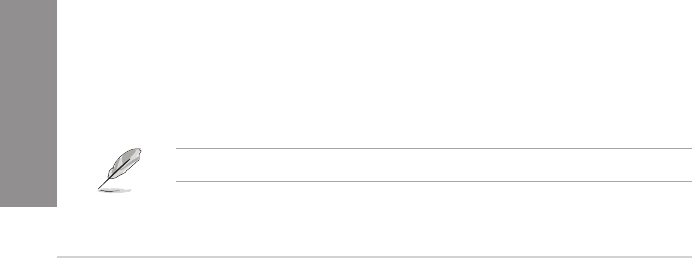
3-24
Chapter 3: BIOS setup
Chapter 3
MISC
DRAM Eventual Voltage (CHA/CHB/CHC/CHD) [Auto]
Use <+> or <-> to adjust the eventual voltages of the DIMM slots. The values range
from 0.8 V to 1.9 V with a 0.10 V increment.
DRAM CLK Period [Auto]
This item allows you to set a DRAM clock period.
Conguration options: [Auto] [1] – [19]
Memory optimize Control [Auto]
This item allows you to optimize the memory control.
Conguration options: [Auto] [Enabled] [Disabled]
Enhanced Training (CHA/CHB/CHC/CHD) [Auto]
Conguration options: [Auto] [Enabled] [Disabled]
MemTest [Auto]
This item allows you to enable or disable the memory testing.
Conguration options: [Enabled] [Disabled]
Attempt Fast Boot [Auto]
This item allows the portion of the memory reference code to be skipped when possible
to increase boot speed.
Conguration options: [Auto] [Enabled] [Disabled]
Attempt Fast Cold Boot [Auto]
This item allows the portion of the memory reference code to be skipped when possible
to increase boot speed.
Conguration options: [Auto] [Enabled] [Disabled]
DRAM Training [Auto]
This item allows your system to set DRAM training test function.
Conguration options: [Auto] [Ignore] [Enable]
External Digi+ Power Control
CPU Input Boot Voltage [Auto]
This item allows you to set a higher CPU input boot voltage for better overclocking
capability. Use the <+> or <-> to adjust the value. The values range from 0.80 V to 2.7
V with an interval of 0.01 V.
CPU Load-line Calibration [Auto]
Load-line is dened by Intel
®
specication and affects CPU power voltage. The CPU
working voltage decreases proportionally to CPU loading. Higher load-line calibration
could get higher voltage and good overclocking performance, but increases the CPU
and VRM thermal conditions. Select from levels 1 to 9 to adjust the CPU power voltage
from 0% to 125%.
Conguration options [Auto] [Level 1] - [Level 9]
The actual performance boost may vary depending on your CPU specication.


















